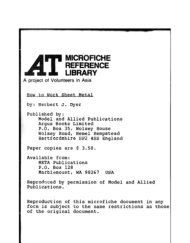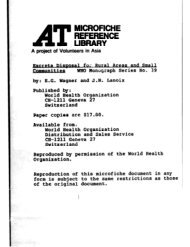Create successful ePaper yourself
Turn your PDF publications into a flip-book with our unique Google optimized e-Paper software.
c<br />
1. \<br />
7 \ ,, ‘\yI #. ”<br />
I h<br />
a<br />
NATURAL PLANT l&ING ’ .” : i<br />
_J “.L4<br />
A ZV&“&I ,the r&?-gm&m mby p.vQduce a better col& In<br />
\ the dyebath than the rosebushes do in the garden ”<br />
N the years since 1964 when Dye<br />
I <strong>Plant</strong>s and <strong>Dyeing</strong> was first published<br />
by the Brooklyn Botanic” Garden, there,<br />
has beep a transition from the objective<br />
intellectual approach to natural plant<br />
dyeing to the praptical desire to apply the<br />
art’ to one’s everyday Jife. This new approach<br />
stems fro’m several factors, including<br />
the resurgence of crafts as a<br />
Fphole, the rejection of anything that is<br />
not “natural,” and the* renewed interest in<br />
the environment that=surrounds us.<br />
In the workshops given at the Botanic<br />
Garden ‘and elsewhere, and in the ‘letters<br />
t&t come to us from all parts of the<br />
world with increa$ng frequency, it has<br />
become apparent that there are many questions<br />
still unanswered and at the same<br />
time much’ inform&ion to be shared. It<br />
was against this background that a .com-’<br />
plementary handbook on dyeing was conceived<br />
and it is hoped that this is-sue wil$<br />
stimulate-further research. .<br />
- In-. discussing the subject of ‘natural<br />
j<br />
dyeing or vegetahle dyeing, too often it,f<br />
I<br />
Palmy Weigle ’ * ,<br />
.<br />
‘. .(<br />
.<br />
the hokplate in the studio or workroom, ’<br />
or the open fire outdoors can give equally,<br />
good results. For utensils, enamel, ‘stain-<br />
less steel .Qr glass pans enable the dyer to<br />
bring out the true colors of the material<br />
he is using. Lined rubber gloves do help<br />
protect the hands fromstains and from ’<br />
excessive ,esposure. ‘to some of the ’ mor-<br />
dants. a!<br />
Mordants are chemical additives that<br />
sometimes help a fiber accept a “aye that it<br />
might previously have rejected. The word<br />
“mordant” stems from the Latin m,ordere<br />
which means “to bite.” It ha$ traditional-<br />
ly been thought that the mordants bite<br />
into the fiber to permit the dy.e bo pene-<br />
trate...$‘rom t+ Idiscussion in this hand- ,c)<br />
book on- page: 51, it ‘appears that this<br />
may very likely-be what does happen.<br />
A detailed explanation of the various . ,<br />
mordants will he foundin DYE <strong>Plant</strong>s and<br />
<strong>Dyeing</strong> (Brooklyn Botanic Garden-Hand- -3 _<br />
hook) on pages’9 to.12. Some of the more<br />
common mordants found in, the recipes<br />
included in this handbook ark : ’<br />
contrasted with chemical dyeing. All d 2 es<br />
have a chemical make-up, just as all fibers<br />
1. Alum (alupiinum<br />
fate), which is usually<br />
potassium sulz<br />
combined with ;<br />
have a chemical composition. The con- cream of tartar in a ratio of 3 parts<br />
trast that, is intended is between those of alum to 1 part of cream of tartar.<br />
dyes that have their basis from objects 2. Cream of ,tartar (potassium bitarfound<br />
in nature as contrasted with those ;trate), used with -alum and sometimes<br />
dyes which stem Ram a laboratory. Dyers with tin >%o help soften, the effect of<br />
throughout history have had a deep inter- those chemicals on ‘the fibers. - 1<br />
est and ‘a working knowledge of the part ,_ 3. Tin (stannous chloride); often used ;.<br />
that chemistry played in achieving the’ as a brightening agent Co make a color<br />
colors they desired. In order to better- sharper or lighter,<br />
understand the nature of thg materials 4. Iron (ferrous sulfate or copperas,<br />
bting used today, please t&n to page S , not to be confused wfth eop,per). In<br />
of this handbobk for a discussion ~f~sorne the dye plant world iron -is . called a 5<br />
of the basic principles<br />
ral dyeing.<br />
involved in natu-<br />
’ I<br />
“saddening” agent ‘because it makes a<br />
color darker or duller. ii<br />
7’<br />
It is not necessary to work in a labora- 5. Chrome, (potassium- dichromate)‘;’ a ~<br />
tory or with highly t.echnical equipment bright orange ‘substance that s<br />
to do natural dyeing. The kitchen stove,<br />
;<br />
A<br />
4<br />
-deepen the colors achieved, and<br />
. _<br />
) ,<br />
_ -.--, < ;<br />
..<br />
I *<br />
-><br />
‘I







